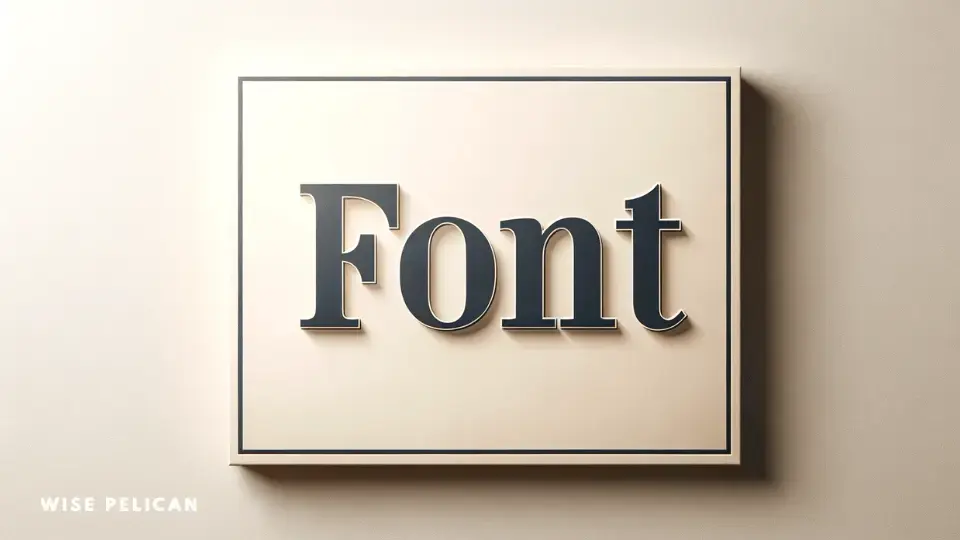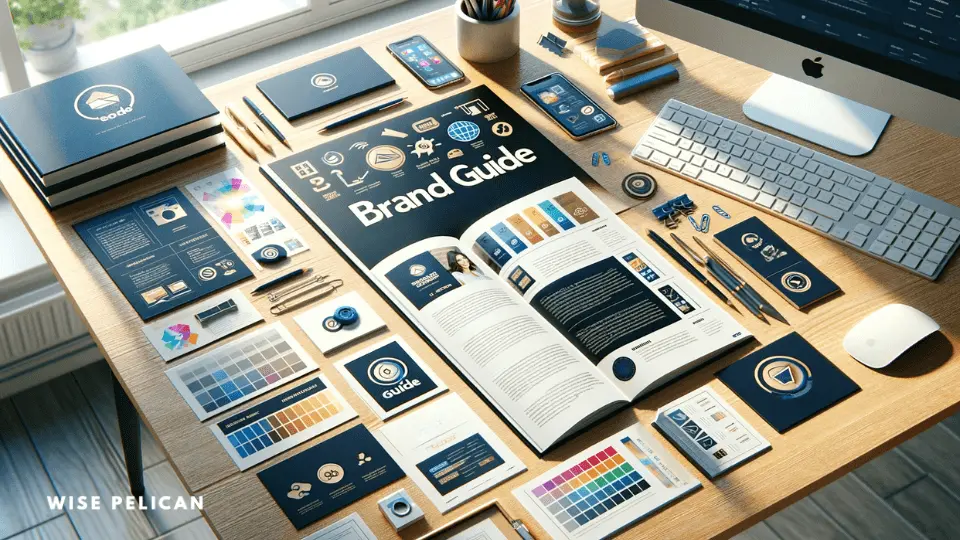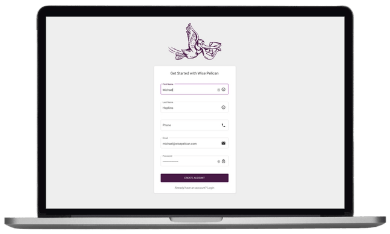We have included our YouTube video if you would prefer to watch a video on the secrets to successful real estate branding.
Branding is a topic that frequently arises in real estate. Whether you’re a newcomer to the field or an established agent looking to carve out your distinct identity apart from your brokerage, understanding the nuances of real estate branding is essential.
This comprehensive guide will tackle the various elements of an effective real estate brand, offering insights and tips to help you establish a lasting impression in the industry.

The Foundations of Real Estate Branding
Several fundamental elements are at the core of every real estate brand, shaping its identity and influencing its perception in the market.
These elements include your logo, color palette, font, name, and headshot. Let’s break down each of these components to understand better how they contribute to your brand’s success.
Your Name is More Than Just a Label
When naming your real estate group or agency, it is crucial to think beyond the immediate present and consider the long-term implications.
Unlike many other businesses, real estate entities often carry the personal touch of their founders, making them closely tied to their identities. However, this connection can limit your options if you ever plan to sell or expand.
Adopting a forward-thinking perspective that extends beyond the immediate present is essential when naming your real estate group or agency. This strategic approach is particularly critical because the name you choose will become a central element of your brand’s identity, which you’ll carry throughout your career.
Personal Touch and Identity
In the real estate industry, it’s common for businesses to bear the personal touch of their founders.
Many real estate professionals incorporate their own names into the business name. For example, “Smith Realty” or “Jones Properties” are common naming conventions. This practice aligns with the idea of building a personal brand, where clients come to trust and rely on the individual agent’s expertise and reputation.

The Limitations of Personalized Real EstateBranding
While attaching your name to your real estate business can establish strong connections with clients and convey a sense of authenticity, it also has limitations. This connection to your personal identity can pose challenges when considering long-term business strategies, such as selling the business or expanding operations. Below are some challenges you may face with personalized branding.
Scalability
Expanding beyond your personal capacity may be challenging if your business is closely tied to your name. As your business grows, it can become increasingly difficult to maintain the same level of personal engagement with clients.
Succession Planning
Planning for the future, including retirement or transitioning the business to a new owner, can be complicated when the brand is deeply rooted in your name. Clients may find accepting a new face or leadership challenging, impacting the business’s value and continuity.
Marketability
When you build a brand solely around your name, it may be less appealing to potential buyers or investors who are interested in acquiring your business. They might be hesitant to take over a brand that is too closely associated with a single individual.
Strategic Branding for Long-Term Success
To address these challenges and position your real estate business for long-term success, consider a more strategic approach to naming.
Versatility
Choose a name that provides flexibility and can accommodate growth. Avoid names that limit your options, even if it means deviating from the traditional practice of using your name.
Distinctiveness
Opt for a name that stands out in the market. A unique and memorable name can help your business attract attention and leave a lasting impression.
Relevance
Ensure that your chosen name aligns with your brand’s values, mission, and the services you provide. A relevant name can help convey what your business represents.
Trademark Considerations
Before finalizing your business name, thoroughly search to ensure it is not already trademarked. This helps prevent legal complications down the road.
Consultation
Seek input from trusted advisors, mentors, or branding professionals. Their perspectives can offer valuable insights and help you make an informed decision.
While incorporating your personal touch into your real estate brand can be a powerful initial strategy for building trust and rapport with clients, thinking strategically about the long-term implications is essential. Choosing a name that allows for scalability, succession planning, and marketability can position your real estate business for sustained success, even as it grows beyond its founder’s identity.

The Power of a Logo in Real Estate Branding
Your logo visually represents your real estate brand and is pivotal in conveying your identity to clients and prospects.
When developing your logo, consider creating two versions: one with a horizontal aspect ratio (typically 16:9) and another in a square format (1:1).
Keep your logo simple, avoiding excessive detail or 3D effects. A cluttered logo can detract from its effectiveness. Limit your color scheme to no more than two colors to maintain visual consistency and recognition.
Your logo is the visual embodiment of your brand’s identity. It is a communication bridge between your business and your clients or prospects. A well-crafted logo can convey your brand’s values, personality, and professionalism at a glance.
Designing Your Logo: Key Considerations
When creating your logo, several critical considerations should guide your design process.
The Role of Aspect Ratio: Horizontal and Square Variations
Creating two versions of your logo with different aspect ratios is a strategic move. Here’s why:
- Horizontal Aspect Ratio (typically 16:9): This version is well-suited for various digital applications, such as website headers, email signatures, and social media cover photos. Its elongated format allows for more flexibility in placement, especially in digital spaces where horizontal space is often abundant.
- Square Format (1:1): The square logo is ideal for profile pictures on social media platforms such as YouTube and Facebook, mobile app icons, and other square or circular spaces. It ensures your logo maintains its integrity and remains visually appealing in confined spaces.
These two variations allow your logo to adapt seamlessly to different platforms and mediums, ensuring your brand identity remains consistent and recognizable.
The Art of Simplicity: Less is More
A simple logo is often more effective and memorable. Here’s why simplicity matters:
- Clarity: A clutter-free design makes it easier for clients and prospects to understand and remember your logo. Complex logos can be confusing and dilute your brand’s message.
- Versatility: A simple logo is versatile and works well in various sizes and contexts. It can be scaled down for a business card or scaled up for a billboard without losing its impact.
- Timelessness: Simple logos tend to age gracefully. They are less likely to become outdated as design trends evolve. Consider iconic logos like Apple or Nike; their simplicity has contributed to their lasting appeal.
The Power of Color: Limiting Your Palette
Limiting your logo’s color scheme to only two colors is a strategic choice with several benefits:
- Recognition: Consistency in color enhances brand recognition. When clients consistently see your logo in the same colors, it becomes ingrained in their memory.
- Visual Cohesion: A limited color palette creates visual cohesion in your branding materials. It ensures that your logo aligns harmoniously with your other branded assets.
- Cost-Efficiency: Printing and reproducing logos with a limited color palette can be more cost-effective. Fewer colors simplify the printing process, reducing expenses.
Avoiding Excessive Detail and 3D Effects
Complexity and excessive detail can diminish the impact of your logo.
- Clarity: Detailed elements can become lost or distorted when scaled down, especially in digital contexts. A simplified design remains legible and recognizable.
- Timelessness: Design trends come and go. A logo with intricate 3D effects may quickly feel outdated, while a clean, flat design stands the test of time.
- Flexibility: Simple logos are more versatile and adaptable. They can easily integrate into various marketing materials and environments without losing effectiveness.
Your logo is a powerful tool for conveying your brand’s identity to clients and prospects. Creating two versions with different aspect ratios, keeping it simple, limiting the color palette, and avoiding excessive detail are vital considerations to ensure your logo effectively represents your brand, remains timeless, and maintains visual consistency across diverse mediums and contexts.

The Right Font for Your Real Estate Brand
Your font choice is essential to your brand’s identity, especially since your name is often incorporated into your logo.
While Sans Serif fonts are popular in modern branding, the font you select should align with your brand’s personality and message. Collaborating with a graphic designer can help you find the perfect font that complements your brand.
Your font selection goes beyond mere aesthetics; it carries profound implications for your brand’s identity and messaging. Here’s a deeper look at why fonts matter so much in branding:
Your Real Estate Brand’s Personality and Message
Fonts have unique personalities and can convey different emotions and attributes. Let’s take a look at some.
- Serif Fonts: These fonts often appear more traditional, formal, and established. They can convey a sense of reliability, tradition, and professionalism.
- Sans Serif Fonts: Sans serif fonts are known for their modern, clean, and minimalist appearance. They convey simplicity, approachability, and a contemporary style.
- Script Fonts: Script fonts mimic handwriting and evoke a sense of personalization, creativity, and elegance.
- Display Fonts: Display fonts are highly decorative and can add personality or playfulness to a brand. They are often reserved for headlines and logos.
Your font choice should align with your brand’s personality and the message you want to convey. Consider the emotions and associations your chosen font might evoke in your target audience. Is it compatible with the image you want to project?
Consistency in Real Estate Branding
Consistency is paramount in branding. Your font choice should be consistent across all brand materials, from your logo to your website, marketing collateral, and emails. Consistency fosters brand recognition and professionalism. It ensures that clients and prospects immediately associate the font with your brand.
Integration with Your Logo
Fonts often play a crucial role in logos, especially when your brand name is incorporated into the logo design. Your font choice in the logo should harmonize with your brand’s identity and be legible and versatile. The font should maintain its clarity and impact when scaled up or down, ensuring it remains effective in various applications.
SIGN UP FOR A FREE WISE PELICAN ACCOUNT
Collaborating with a Graphic Designer
Selecting the perfect font for your brand can be a nuanced and intricate process. Collaborating with a graphic designer who specializes in branding can be immensely valuable.
- Expertise: Graphic designers possess expertise in typography and branding. They can evaluate various fonts in the context of your brand and provide insights into which one best aligns with your objectives.
- Customization: Designers can also customize fonts, adjusting letterforms and spacing to create a unique, tailored typeface that embodies your brand’s personality.
- Comprehensive Branding: Graphic designers consider the holistic view of branding, ensuring that the font complements other visual elements, such as colors, graphics, and imagery.
- Technical Proficiency: Designers understand the technical aspects of font usage, ensuring the font is compatible with various platforms and can be reproduced consistently.
The font choice for your brand is far more than a design decision; it’s a strategic one. It should align with your brand’s personality and message, effectively communicating your identity to your audience. Collaborating with a graphic designer can help you navigate this intricate process, leading to a font choice that complements your brand and enhances its visual appeal and impact.

The Colors of Your Brand
Color psychology is a fascinating field, but personal preference should take precedence when selecting colors for your real estate brand. The colors you choose should reflect your personality and resonate with you. After all, your brand colors will appear on everything from marketing materials to signage; they should be colors you’re proud to represent.
While color associations like purple for royalty and blue for trust exist, don’t get bogged down in the details of color psychology. Instead, focus on what feels right for you and your brand.
Personal Connection: Your Brand’s Emotional Resonance
Your brand’s colors should resonate with you personally because they are an extension of your identity as a real estate professional. When you feel a personal connection to your brand colors, conveying authenticity and sincerity to your clients and prospects becomes easier.
Colors can evoke a wide range of emotions and associations. They can reflect your personality traits, values, and the unique approach you bring to your real estate services.
For example, warm and vibrant colors convey enthusiasm and energy, while cooler, muted tones suggest a calm and composed demeanor. Ultimately, your brand colors should align with your genuine self and the qualities you want to convey in your real estate business.
Visual Consistency: A Unified Brand Image
When you choose colors that genuinely resonate with you, it’s easier to maintain visual consistency across all your brand materials. Whether it’s your website, business cards, signage, or proof of production postcards, your brand colors should create a cohesive and unified image.
Consistency helps clients and prospects recognize your brand instantly. They become accustomed to the colors associated with your real estate services, which, in turn, reinforces your brand’s presence in their minds.
Color Psychology: Balancing Science and Personal Connection
While color psychology provides valuable insights into the potential psychological effects of colors, it’s important not to become overly fixated on these associations. Color psychology suggests that certain colors can elicit specific emotions or perceptions.
However, these associations are not rigid rules but rather general trends. The power of personal connection should not be underestimated. Your unique blend of personality, experiences, and values can give your chosen colors a different context and meaning within the realm of your brand.
Authenticity Over Conformity
Instead of adhering strictly to established color associations, consider how your personal preference and unique brand identity can redefine these associations. Authenticity is often more compelling than conforming to industry norms.
By staying true to your personal connection with your brand colors, you create an authentic and memorable brand that genuinely represents you. Clients and prospects are more likely to resonate with your brand when they sense authenticity, as it promotes trust and relatability.
Selecting colors in real estate branding is a delicate balance between the fascinating world of color psychology and your personal connection to your brand.

The Importance of Templates
Creating templates for various marketing materials is a cornerstone of effective branding. These templates ensure consistency in your messaging and design, enhancing brand recognition among your audience.
Whether you’re creating Facebook ads, postcards, brochures, letterhead, or any printed material, having templates in place is vital.
Templates are more than just design tools; they are a strategic asset in building and maintaining a strong brand presence. Here’s a deeper look at why templates are indispensable:
Ensuring Brand Consistency
When your audience encounters your materials, whether online or offline, they should immediately recognize your brand. Templates play a pivotal role in achieving this consistency:
- Messaging: Templates ensure that your messaging remains consistent across different marketing materials. Whether it’s a Facebook post or a postcard, the core message and tone should align with your brand’s identity.
- Design: Design elements such as color schemes, fonts, and layouts should remain consistent. Templates serve as a visual guide, ensuring your brand’s visual identity remains intact across various materials.
Enhancing Brand Recognition
Effective branding aims to create a lasting impression in the minds of your audience. When your audience consistently sees materials with a unified look and feel, they are more likely to remember and recognize your brand. Templates contribute to brand recognition in several ways:
- Familiarity: Templates create a sense of familiarity. When your audience encounters materials that follow the same format and design guidelines, they become accustomed to your brand’s style.
- Repetition: Repetition is key to memory. Using templates consistently reinforces your brand’s presence, making it more likely that your audience will remember and recall your brand when needed.
Efficiency and Time Savings
Templates streamline the content creation process. They provide a structured framework that simplifies designing and producing marketing materials. This efficiency has several benefits:
- Time Savings: Templates save you time and effort. Rather than starting from scratch each time you create a new material, you can use a pre-designed template as a foundation.
- Consistency Across Team: If you have a team or work with collaborators, templates ensure everyone follows the same design and messaging guidelines. This consistency is especially crucial for real estate teams or agencies with multiple members.
Adaptability and Scalability
As your real estate business grows, you’ll likely need to produce various marketing materials for different purposes and audiences. Templates provide adaptability and scalability:
- Adaptability: Templates can be customized to suit specific marketing goals or campaigns while maintaining the overall brand identity.
- Scalability: As your business expands, templates can be easily replicated and adapted for various regions, property types, or marketing strategies.
Streamlining Branding Efforts
Templates extend to other brand elements, such as email signatures, social media posts, and presentations, in addition to marketing materials. This cohesive approach ensures that every touchpoint with your audience consistently reinforces your brand’s identity.
Templates are a cornerstone of effective branding in the real estate industry. They promote brand consistency, enhance recognition, save time, and provide adaptability as your business grows.
Using templates for various marketing materials and touchpoints creates a cohesive and memorable brand that helps you stand out in a competitive market.
Consistency is Key
Consistency is the hallmark of a strong brand. Just like well-known brands such as McDonald’s or Tiffany’s, your audience should come to expect a specific look and feel from your marketing materials. Your brand should evoke familiarity and trust.
Crafting Templates for Success
When developing templates in real estate branding, consider the following key components:
- Proof of Production Template: Showcase your successes and achievements with a consistent template highlighting your track record.
- Automated Seller Valuation Template: Offer homeowners a clear view of their property’s value with a template that conveys professionalism and expertise.
- Market Update Template: Keep your audience informed about market trends with a template that presents data clearly and engagingly.
Maintain a small selection of templates to reinforce brand recognition and ensure your audience knows what to expect from your communications.
BROWSE WISE PELICAN REAL ESTATE POSTCARDS
Proof of Production Template: Highlighting Success
The Proof of Production template is a powerful tool for showcasing your accomplishments and track record as a real estate professional. It serves as a visual testament to your success. Here’s a more detailed look at its significance:
Illustrating Expertise: This template allows you to present data and statistics demonstrating your expertise and achievements. It can include information such as the number of properties sold, client testimonials, or awards received.
Building Trust: You build trust with your audience by consistently sharing your successes through this template. Clients are more likely to trust an agent with a proven track record of success.
Reinforcing Brand Identity: Ensure that the design elements, colors, and typography of your Proof of Production template align with your brand identity. This reinforces brand recognition and consistency.
Automated Seller Valuation Template: Demonstrating Professionalism
The Automated Seller Valuation template is invaluable for engaging homeowners and offering them insights into their property’s value.
Client Engagement: By providing homeowners with a clear and professional property valuation, you engage potential sellers and position yourself as a trusted expert in the real estate market.
First Impression: This template often serves as a homeowner’s first interaction with your brand. A well-designed and informative template creates a positive first impression and sets the stage for further interactions.
Data Accuracy: Accuracy is paramount in property valuations. Ensure that your template is designed to provide accurate estimates, enhancing your reputation for professionalism and reliability.
Market Update Template: Informing and Engaging
The Market Update template informs your audience about real estate market trends and developments. Here’s why it’s essential:
- Education: Your audience relies on you for insights into the market. A well-structured template lets you present data, charts, and analysis clearly and engagingly, helping clients make informed decisions.
- Trust Building: Regularly sharing market updates demonstrates your commitment to informing clients. It reinforces your role as a trusted advisor and expert in the field.
- Content Consistency: Consistency in your Market Update template ensures clients know what to expect from your communications. It also reinforces your brand’s identity and professionalism.
Maintaining a Small Selection of Templates: Brand Recognition
Limiting the number of templates you use is a strategic choice that enhances brand recognition and consistency.
Recognition: When your audience consistently sees materials with a unified look and feel, they can quickly recognize your brand, fostering trust and loyalty.
Simplicity: A smaller selection of templates simplifies your branding efforts. It ensures that your team, if you have one, adheres to consistent design and messaging guidelines.
Streamlining Production: By selecting a small number of templates, you can streamline the production process, saving time and resources.
Developing and utilizing these key templates is essential for establishing a solid, cohesive real estate brand. They allow you to highlight your successes, demonstrate professionalism, keep your audience informed, and maintain communication consistency. Adhering to a small selection of templates reinforces brand recognition. It ensures your audience knows what to expect from your interactions, ultimately building trust and credibility in the competitive real estate market.

The Brand Style Guide: Your North Star
A brand style guide is an indispensable tool for maintaining the integrity of your brand. It serves as a set of guidelines that dictate how your brand should be presented across all channels. Any person or team working on your brand materials should have access to this guide and adhere to its instructions.
The Role of a Brand Style Guide
A brand style guide, often called a brand guide or brand standards manual, is a comprehensive document that outlines the guidelines, rules, and standards for how your brand should be represented consistently across all channels and touchpoints. It serves as a safeguard for your brand’s identity and reputation. Let’s explore why a brand style guide is crucial.
Ensuring Consistency Across All Materials
Consistency is the backbone of effective branding. Your brand style guide ensures that every piece of communication, whether it’s a social media post, a print advertisement, a website, or a business card, adheres to a unified set of standards. This consistency helps your audience recognize and remember your brand, fostering trust and reliability.
Protecting Brand Integrity
A brand style guide acts as a protector of your brand’s integrity. It establishes clear rules for using your logo, color palette, fonts, imagery, and messaging. Providing these guidelines prevents any inadvertent deviations that could dilute your brand’s identity or impact its perception.
Streamlining Design and Content Creation
A brand style guide streamlines the creative process for real estate professionals working with teams or collaborating with designers and marketers. It provides a roadmap for creating materials, saving time and resources. Team members can refer to the guide to ensure their work aligns with your brand’s vision and goals.
Enhancing Professionalism
A well-documented brand style guide conveys professionalism and attention to detail. It demonstrates that you take your brand seriously and are committed to presenting it in the best possible light. This professionalism resonates with clients and prospects, instilling confidence in your services.
Managing Brand Evolution
Brands evolve over time, adapting to changing markets and audience preferences. A brand style guide is a living document that can grow alongside your brand. It can be updated to reflect branding elements, messaging, or design standards changes. This ensures your brand remains relevant and consistent as it grows and evolves.
Ensuring Cross-Team Alignment
Collaboration among different team members is common in real estate. A brand style guide is a central reference point that aligns everyone involved in brand-related activities. It ensures that agents, marketers, designers, and other stakeholders all work towards a shared brand vision.
Reducing the Risk of Misrepresentation
Without a brand style guide, there’s a risk that various individuals or teams may interpret and represent your brand differently. This inconsistency can confuse your audience and negatively impact brand perception. A well-maintained brand style guide minimizes this risk by providing clear, unambiguous instructions.
A brand style guide is a critical tool for maintaining the integrity and consistency of your real estate brand. It serves as a set of guidelines that ensure your brand is presented accurately and cohesively across all channels. Any person or team working on your brand materials should have access to this guide and rigorously adhere to its instructions to protect and enhance your brand’s reputation and impact.
Upholding Brand Consistency: The Foundation of Brand Strength
Consistency in branding is not merely a suggestion; it’s a fundamental principle that underpins your brand’s strength and impact. It encompasses every aspect of how your brand is presented to the world, from visual elements to messaging and tone.
Reinforces Brand Recognition
Consistency creates a sense of familiarity. When your audience encounters your brand across various touchpoints—your website, social media, marketing materials, or signage—they should immediately recognize it. This recognition fosters trust and helps your brand stand out in a crowded real estate market.
Builds Trust and Reliability
Trust is paramount in the real estate industry. Clients and prospects who see consistent branding are more likely to perceive your brand as reliable and professional. They feel that they know what to expect from your services, which instills confidence in their decision to work with you.
Strengthens Brand Identity
A strong brand identity sets you apart from competitors and defines who you are as a real estate professional. Deviating from your established brand can dilute this identity and confuse your audience. Consistency in branding reinforces and strengthens your brand identity.
Supports Marketing and Advertising Efforts
Marketing and advertising campaigns are most effective when they align with your brand’s identity and messaging. Deviating from the brand can lead to disjointed campaigns that lack impact. Consistency ensures that your marketing materials and messages are aligned with your brand’s core values and objectives.
Minimizes Customer Confusion
Inconsistent branding can lead to confusion among your clients and prospects. They may question your professionalism and reliability when encountering conflicting brand messages or visual elements. Consistency in branding minimizes this confusion and reinforces a clear, cohesive brand image.
Ensuring Team Adherence to the Brand Style Guide
If you have a real estate team working under your brand, whether it’s fellow agents, marketers, or designers, it’s essential to ensure that they understand and respect the brand style guide. Here’s why this is vital:
Team Alignment
A cohesive team that aligns with the brand style guide is essential for consistent branding efforts. Everyone should clearly understand the guidelines and how they apply to their respective roles.
Accountability
By clearly communicating the importance of brand consistency and holding your team accountable for adhering to the brand style guide, you create a culture of accountability within your organization. Team members understand their role in maintaining brand integrity.
Effective Collaboration
Effective collaboration relies on everyone speaking the same brand language. Collaboration becomes more efficient when your team follows the brand style guide, and everyone works toward a unified vision.
Brand Ambassadors
Your team members are brand ambassadors. When they understand and respect the brand style guide, they advocate for your brand, consistently conveying its message and values to clients and prospects.
Maintaining brand consistency is not a rigid stance but a strategic imperative. Consistency reinforces brand recognition, builds trust, and strengthens your brand identity. When a team works under your brand, ensure they fully grasp and respect the brand style guide. This commitment to consistency enhances your brand’s impact and sets a strong foundation for your real estate business’s long-term success.

The Pitfalls of Inconsistency
Real estate agents sometimes undermine their brands by succumbing to the temptation of frequently changing the appearance of their materials.
This inconsistency can confuse clients and dilute brand recognition. Whether you aspire to be the McDonald’s or the Tiffany’s of real estate, a steadfast commitment to a clear and consistent brand is essential.
Establishing a strong and lasting brand in real estate is vital to being a successful real estate agent. Your brand encompasses more than just a name and logo; it contains your identity, values, and the promise you deliver to your clients.
By strategically naming your brand, designing a compelling logo, selecting appropriate fonts and colors, and creating consistent templates, you can build a real estate brand that stands the test of time. And remember, a brand style guide will serve as your North Star, ensuring that every aspect of your brand remains true to its essence.
Ultimately, the key to successful real estate branding lies in consistency, reliability, and a commitment to delivering exceptional service—a brand that clients can trust, just like the familiar golden arches or the iconic Tiffany blue box.
The Pitfall of Frequent Changes in Brand Appearance
The desire to stand out can sometimes lead agents to change the appearance of their brand materials constantly.
While a fresh look might initially capture attention, this inconsistency can inadvertently undermine the brand’s long-term impact. Let’s take a closer look at why resisting this temptation is essential.
Confusion
Frequent changes can confuse clients and prospects. When your audience encounters different looks, logos, or messaging from your brand, they may struggle to recognize and remember you. Consistency ensures that your brand remains clear and memorable.
Dilution of Recognition
Brand recognition is a gradual process that builds over time. Consistency in branding elements, such as colors, fonts, and logos, reinforces this recognition. Changing these elements frequently dilutes your brand’s recognition potential.
Brand Trust
Trust is a vital currency in real estate. Clients rely on a consistent brand to deliver on its promises. When you frequently change your brand’s appearance, it may raise questions about your commitment and reliability.
A steadfast commitment to a clear and consistent brand is essential for long-term success. Your brand encompasses not just your name and logo but your identity, values, and the promise you deliver.
By strategically crafting and maintaining your brand elements, guided by a brand style guide, you can build a real estate brand that endures and becomes a trusted name in the industry—a brand that clients can rely on and remember, just like the most iconic brands across various sectors.
Wise Pelican Can Help With Your Branding Needs
Boost your real estate business with Wise Pelican’s targeted direct mail marketing. Stand out in a crowded market – connect with us now to create a compelling brand presence that resonates with your audience!






